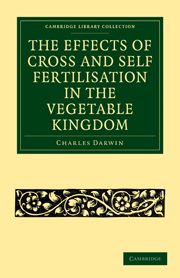Book contents
- Frontmatter
- Contents
- CHAPTER I INTRODUCTORY REMARKS
- CHAPTER II CONVOLVULACEÆ
- CHAPTER III SCROPHULARIACEÆ, GESNERIACEÆ, LABIATÆ, ETC
- IV CRUCIFERÆ, PAPAVERACEÆ, RESEDACEÆ, ETC
- CHAPTER V GERANIACEÆ, LEGUMINOSÆ, ONAGRACEÆ, ETC
- CHAPTER VI SOLANACEÆ PRIMULACEÆ, POLYGONEÆ, ETC
- CHAPTER VII SUMMARY OF THE HEIGHTS AND WEIGHTS OF THE CROSSED AND SELF-FERTILISED PLANTS
- CHAPTER VIII DIFFERENCE BETWEEN CROSSED AND SELF-FERTILISED PLANTS IN CONSTITUTIONAL VIGOUR AND IN OTHER RESPECTS
- CHAPTER IX THE EFFECTS OF CROSS-FERTILISATION AND SELF-FERTILISATION ON THE PRODUCTION OF SEEDS
- CHAPTER X MEANS OF FERTILISATION
- CHAPTER XI THE HABITS OF INSECTS IN RELATION TO THE FERTILISATION OF FLOWERS
- CHAPTER XII GENERAL RESULTS
- INDEX
CHAPTER III - SCROPHULARIACEÆ, GESNERIACEÆ, LABIATÆ, ETC
Published online by Cambridge University Press: 29 August 2010
- Frontmatter
- Contents
- CHAPTER I INTRODUCTORY REMARKS
- CHAPTER II CONVOLVULACEÆ
- CHAPTER III SCROPHULARIACEÆ, GESNERIACEÆ, LABIATÆ, ETC
- IV CRUCIFERÆ, PAPAVERACEÆ, RESEDACEÆ, ETC
- CHAPTER V GERANIACEÆ, LEGUMINOSÆ, ONAGRACEÆ, ETC
- CHAPTER VI SOLANACEÆ PRIMULACEÆ, POLYGONEÆ, ETC
- CHAPTER VII SUMMARY OF THE HEIGHTS AND WEIGHTS OF THE CROSSED AND SELF-FERTILISED PLANTS
- CHAPTER VIII DIFFERENCE BETWEEN CROSSED AND SELF-FERTILISED PLANTS IN CONSTITUTIONAL VIGOUR AND IN OTHER RESPECTS
- CHAPTER IX THE EFFECTS OF CROSS-FERTILISATION AND SELF-FERTILISATION ON THE PRODUCTION OF SEEDS
- CHAPTER X MEANS OF FERTILISATION
- CHAPTER XI THE HABITS OF INSECTS IN RELATION TO THE FERTILISATION OF FLOWERS
- CHAPTER XII GENERAL RESULTS
- INDEX
Summary
In the family of the Scrophulariacese I experimented on species in the six following genera: Mimulus, Digitalis, Calceolaria, Linaria, Verbascum, and Vandellia.
SCROPHULARIACEÆ.—Mimulus luteus.
The plants which I raised from purchased seed varied greatly in the colour of their flowers, so that hardly two individuals were quite alike; the corolla being of all shades of yellow, with the most diversified blotches of purple, crimson, orange, and coppery brown. But these plants differed in no other respect. The flowers are evidently well adapted for fertilisation by the agency of insects; and in the case of a closely allied species, M. rosea, I have watched bees entering the flowers, thus getting their backs well dusted with pollen; and when they entered another flower the pollen was licked off their backs by the two-lipped stigma, the lips of which are irritable and close like a forceps on the pollen-grains. If no pollen is enclosed between the lips, these open again after a time. Mr. Kitchener has ingeniously explained the use of these movements, namely, to prevent the self-fertilisation of the flower. If a bee with no pollen on its back enters a flower it touches the stigma, which quickly closes, and when the bee retires dusted with pollen, it can leave none on the stigma of the same flower. But as soon as it enters any other flower, plenty of pollen is left on the stigma, which will be thus cross-fertilised.
- Type
- Chapter
- Information
- Publisher: Cambridge University PressPrint publication year: 2009First published in: 1876



